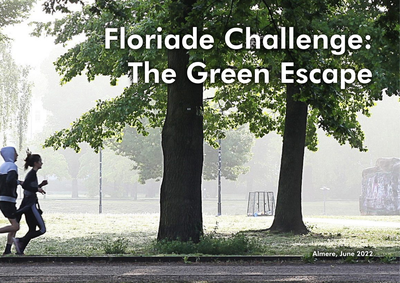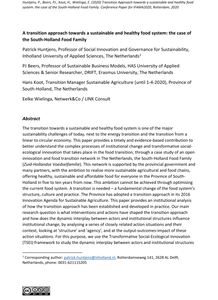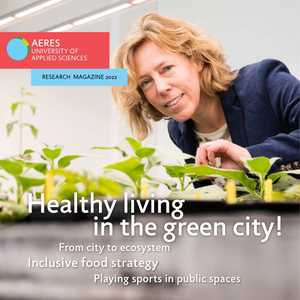Wat is healthy ageing? In dit hoofdstuk bespreken de auteurs een aantal definities en gaan ze in op de 'Big Five for a Healthy Life". Ook wordt gezond ouder worden in het kader van de levensloopbenadering geplaatst, waarbij het leven van mensen beschouwd wordt als een aaneenschakeling van levensfasen en levensgebeurtenissen. Elke gebeurtenis of situatie kan in de context van de levensfase betekenis krijgen. Centraal in deze benadering staat dat elke fase gepaard gaat met uitdagingen en dat in elke fase veranderingen en aanpassingen nodig zijn om gezond oud(er) te worden.
LINK
In dit artikel wordt gekeken naar de relatie tussen het gebruik van mobiele applicaties en fysieke activiteit en gezonde leefstijl. Dit is gedaan op basis van een vragenlijst onder deelnemers aan een hardloopevenement, de Dam tot Damloop. Er werden aparte analyses gedaan voor 8km lopers en 16 km lopers. Een positieve relatie werd gevonden tussen app gebruik en meer bewegen en zich gezonder voelen. App gebruik was ook positief gerelateerd aan beter voelen over zichzelf, je voelen als een atleet, anderen motiveren om te gaan hardlopen en afvallen. Voor de 16 km lopers was app gebruik gerelateerd aan gezonder eten, zich meer energieker voelen en een hogere kans om het sportgedrag vol te houden. De resultaten van dit onderzoek laten zien dat app gebruik mogelijk een ondersteunende rol kunnen hebben in de voorbereiding op een hardloopevenemen, aangezien het gezondheid en fysieke activiteit stimuleert.
DOCUMENT

Almere is a green city where the greenery extends into the centre through a framework of nature, forests, parks and canals. With this green environment, Almere fulfils an important condition for a liveable city, where it is pleasant to live and work. An important goal for the municipality is to challenge its residents to develop a healthy lifestyle by using that green framework.But what really motivates Almeerders to go outside to exercise, enjoy the surroundings and meet each other? Are there sufficient green meeting or sports facilities nearby? Could the routes that connect the living and working environment with the larger parks or forests be better designed? And can those routes simultaneously contribute to climate adaptation?With the Green Escape Challenge, we invited students and young professionals to work on these assignments together.
DOCUMENT

This toolkit therefore focusses on self-management abilities. That means finding and maintaining effective, positive coping methods in relation to our health. We included many common and frequently discussed topics such as drinking, eating, physical exercise, believing in the future, resilience, preventing loneliness and social participation. Besides some concise background information, we offer you a great diversity of exercises per theme which can help you discuss, assess, change or strengthen your personal state of health. In case you are mentoring or coaching a group of seniors with regards to living a healthy and active life, this toolkit also offers explanations on how to lead a team of peers
DOCUMENT

A significant contributor to the global threat of obesity is excessive gestational weight gain (GWG). The aim of this article is to explore Dutch primary care midwives’ behaviors in promoting healthy GWG.
DOCUMENT

Given the growing number of older people, society as a whole should ideally provide a higher quality of life (QoL) for its ageing citizens through the concept of personalised ageing. Information and communication technologies (ICT) are subject to constant and rapid development, and can contribute to the goal of an improved QoL for older adults. In order to utilise future ICT solutions as a part of an age-friendly smart environment that helps achieve personalised ageing with an increased QoL, one must first determine whether the existing ICT solutions are satisfying the needs of older people. In order to accomplish that, this study contributes in three ways. First, it proposes a framework for the QoL of older adults, in order to provide a systematic review of the state-of-the-art literature and patents in this field. The second contribution is the finding that selected ICT solutions covered by articles and patents are intended for older adults and are validated by them. The third contribution of the study are the six recommendations that are derived from the review of the literature and the patents which would help move the agenda concerning the QoL of older people and personalised ageing with the use of ICT solutions forward. Original article at MDPI; DOI: http://dx.doi.org/10.3390/ijerph17082940 (This article belongs to the Special Issue Feature Papers "Age-Friendly Cities & Communities: State of the Art and Future Perspectives")
MULTIFILE

Physical inactivity is a growing public health concern. Use of mobile applications (apps) may be a powerful tool to encourage physical activity and a healthy lifestyle. For instance, apps may be used in the preparation of a running event. However, there is little evidence for the relationship between app use and change in physical activity and health in recreational runners. The aim of this study was to determine the relationship between the use of apps and changes in physical activity, health and lifestyle behaviour, and self-image of short and long distance runners.
DOCUMENT

Purpose The purpose of this research was to explore women’s experiences after breast surgery with scar characteristics and symptoms, and its impact on their health-related quality of life (HRQOL). Material andmethods A qualitative study using semi-structured face-to-face interviewswas conducted among women following prophylactic, oncologic, or reconstructive breast surgery in the Netherlands. A directed content analysis was performed using guiding themes. Themes were “physical and sensory symptoms,” “impact of scar symptoms,” “personal factors,” “impact of scar interventions,” and “change over time.” Results The study population consisted of 26 women after breast surgery. Women experienced a wide range of symptoms like adherence, stiffness, pain, and uncomfortable sensations. Scar characteristics as visibility, location, texture, and size, influenced satisfaction with their appearance. The impact of scar symptoms is reflected in physical, social, emotional, and cognitive functioning, thereby affecting HRQOL. The experienced impact on HRQOL depended on several factors, like personal factors as the degree of acceptance and environmental factors like social support. Conclusion Women can experience a diversity of scar characteristics and symptoms, which play a central role in the perceived impact on HRQOL. Since scarring can have a considerable impact on HRQOL, scarring after prophylactic, oncologic and reconstructive breast surgery should be given more attention in clinical practice and research. Implications for Cancer Survivors Considering scarring as a common late effect after breast surgery and understanding the variety of experiences, which could impact HRQOL of women, can be beneficial in sufficient information provision, expectation management, and informed decision making.
DOCUMENT

The transition towards a sustainable and healthy food system is one of the major sustainability challenges of today, next to the energy transition and the transition from a linear to circular economy. This paper provides a timely and evidence-based contribution to better understand the complex processes of institutional change and transformative social-ecological innovation that takes place in the food transition, through a case study of an open innovation and food transition network in The Netherlands, the South-Holland Food Family (Zuid-Hollandse Voedselfamilie). This network is supported by the provincial government and many partners, with the ambition to realize more sustainable agricultural and food chains, offering healthy, sustainable and affordable food for everyone in the Province of South-Holland in five to ten years from now. This ambition cannot be achieved through optimising the current food system. A transition is needed – a fundamental change of the food system’s structure, culture and practice. The Province has adopted a transition approach in its 2016 Innovation Agenda for Sustainable Agriculture. This paper provides an institutional analysis of how the transition approach has been established and developed in practice. Our main research question is what interventions and actions have shaped the transition approach and how does the dynamic interplay between actors and institutional structures influence institutional change, by analysing a series of closely related action situations and their context, looking at 'structure' and 'agency', and at the output-outcomes-impact of these action situations. For this purpose, we use the Transformative Social-Ecological Innovation (TSEI)-framework to study the dynamic interplay between actors and institutional structures influencing institutional change. The example of TSEI-framework application in this paper shows when and how local agents change the institutional context itself, which provides relevant insights on institutional work and the mutually constitutive nature of structure and agency. Above institutional analysis also shows the pivotal role of a number of actors, such as network facilitators and provincial minister, and their capability and skills to combine formal and informal institutional environments and logics and mobilize resources, thereby legitimizing and supporting the change effort. The results are indicative of the importance of institutional structures as both facilitating (i.e., the province’s policies) and limiting (e.g. land ownership) transition dynamics.
DOCUMENT

With the beautiful new building of Aeres University of Applied Sciences Almere in the Floriade park, we have materialized our wish to lead the way in the green transition and its challenges. We want to be green changemakers and have the ambition to take on the challenges that we are faced with in agriculture, food and healthy living environments. We bring this about with our study programmes and increasingly with our Practice-Based Research Team. In 10 years’ time, this team has grown from our first professorship into a mature team of 20 people, of whom 7 are research professors.In this edition, three of our new professors will be introduced to you.
DOCUMENT
